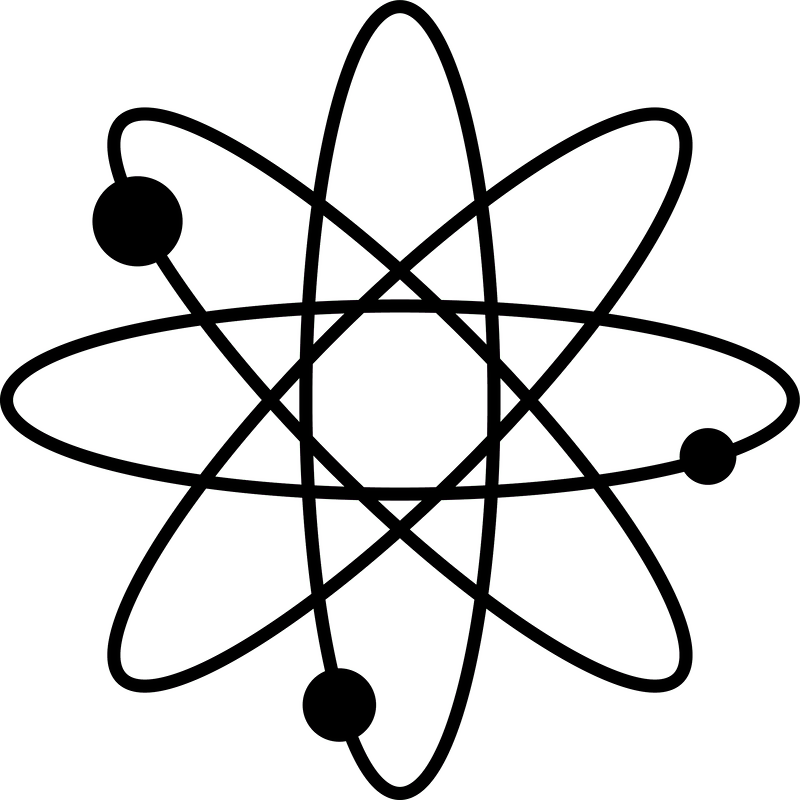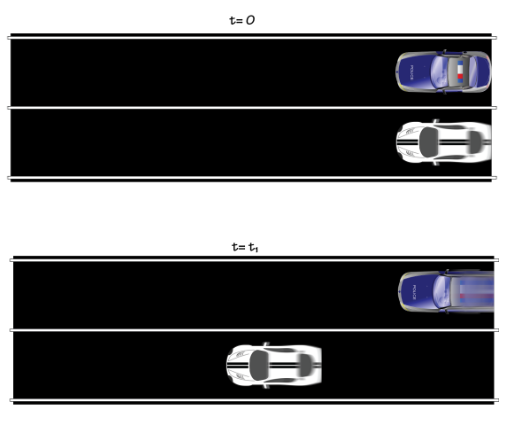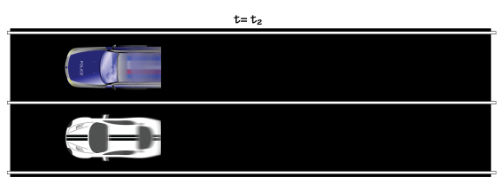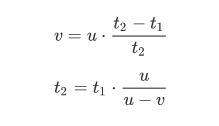 Physics Primer
Physics Primer
物理入门
Physics Primer
This physics primer will take you throughthe solution of a basic kinematics problem.
这个物理入门将带你通过一个基本运动学问题的解决方案。
Racing on the Highway
在公路上赛跑
A car is racing on the highway. At themoment t=0 it passes by a police car. The police car starts chasing the racingcar at the moment t=t1 and it reaches the racing at the moment t=t2.The velocity of the racing is v, and the velocity of the police car is u. Wewill assume that the cars are always moving with constant speed. We will tackletwo questions:
一辆汽车在公路上行驶。目前,T = 0,它经过一辆警车。警车开始追逐赛车时的 t=t1,它到达赛车在目前的 t=t2。赛车的速度是v,警车的速度是U。我们将假定汽车总是以恒定的速度运动。我们将处理两个问题:
If we know the velocity of the police car(u), and the time when it starts the chase (t1) and the time when itreaches the racing (t2), what is the velocity of the racing car (v)?
如果我们知道警车(U)的速度,以及它开始追逐(t1)的时间和到达赛车(t2)的时间,赛车的速度是多少?
If we know the velocity of the police car(u), the velocity of the racing car (v) and the time when the police car startsthe chase (t1), what is the time (t2) when the police carreaches the racing car?
如果我们知道警车(U)的速度,赛车的速度(V)和警车开始追逐的时间(t1),警车到达赛车的时间(t2)是什么时候?


Solution
解决方案
When tackling such a problem don’t startwith writing down formulas. Instead, think about the best way of relating therelevant quantities. What connects them? The answer to this question will neverbe a formula, but a physical insight in the problem.
解决这个问题时,不要先写下公式。相反,想想最好的方法来联系有关的数量。他们之间有什么联系?这个问题的答案绝不是公式,而是问题的物理洞察力。
In the case of our problem, the keyobservation is to notice that the police car and the racing car are in the sameplace at the time t=0 and the time t=t2. This means that in the timet2 they both covered the same distance.
就我们的问题而言,关键的观察是注意警车和赛车在T=0和时间t=t2时处于同一位置。这意味着在t2时它们都覆盖相同的距离。
Distance covered by racing car in the timet2=Distance covered by police car in the time t2
Now we just need to relate this distance tothe velocity of the two cars. The racing car is moving at a constant speedthroughout the time t2, so it will cover a distance:
就我们的问题而言,关键的观察是注意警车和赛车在T=0和时间t=t2时处于同一位置。这意味着在t2时它们都覆盖相同的距离。
D=v⋅t2
The police car only starts moving at thetime t1. That means that it only moves for the time t2−t1.For this period of time its speed is constant, so it will cover a distance:
警车在t1时才开始移动。这意味着,它只会在时间t2−t1。在这段时间内,它的速度是恒定的,所以它将覆盖一段距离:
D=u⋅(t2−t1)
But we know that both cars cover the samedistance, so
但我们知道这两辆车的距离是一样的,所以
v⋅t2=u⋅(t2−t1)
This is the equation that solves both ourquestions. If we want we can determine v, or t2:
这是解决我们两个问题的等式。如果我们想,我们可以确定v,或t2:

Verification
验证
The best practice is to always check youranswers. This implies not only double checking the algebraic manipulations, butchecking especially the soundness of the physical answer. Most often you willspot mistakes by realizing that your answer doesn’t make physical sense.
最好的做法是经常检查你的答案。这意味着不仅要检查代数操作,还要检查物理回答的正确性。大多数情况下,你会发现你的答案没有物理意义,从而发现错误。
Dimensions
维度
The golden rule of dimensional analysisrequires that dimensions on the left must match dimensions on the right. Noticethat each fraction has no dimensions because it is a ratio of two quantitieswith the same dimension (time over time, velocity over velocity). So only theterm in front matters in terms of dimensions. Fortunately we got a velocity onboth sides, and a time on both sides. ✓
维度分析的黄金规则要求左边的维度必须与右边的维度匹配。请注意,每个分数没有量纲,因为它是两个数量相同的维度(时间随时间,速度超过速度)的比率。因此,只有前面的术语在维度上起作用。幸运的是,我们两边都有速度,两边都有时间。✓
Physical Intuition
物理直觉
A solution must make physical sense. Because the police car catches up with theracing car, it is clear that it must move faster than the racing car. That is,v<u. This is true because . Inthe case of the time solution, we must check that our answer is positive: u−v>0,all good here. And that t2>t1, which is true because
. Inthe case of the time solution, we must check that our answer is positive: u−v>0,all good here. And that t2>t1, which is true because . ✓
. ✓
解决办法必须有物理意义。因为警车赶上了赛车,很明显它必须比赛车快。即v<u这是因为 。在时间的解决方案的情况下,我们必须检查我们的答案是肯定的:u−v>0,所有好的这里。而T2>T1,这是真的因为
。在时间的解决方案的情况下,我们必须检查我们的答案是肯定的:u−v>0,所有好的这里。而T2>T1,这是真的因为 。✓
。✓
When typing the solution I mistakenly switchedu and v – this is an easy to make mistake because there is no sign to pointwhich velocity corresponds to which car. I spotted the mistake when checking ifmy answer made sense.
在键入解决方案时,我错误地将u和v切换,这是一个容易犯的错误,因为没有迹象表明哪个速度对应哪一辆车。当我检查我的回答是否有意义时,我发现了这个错误。


